Aerodynamic Analysis and Three-Dimensional Redesign of a Multi-Stage Axial Flow Compressor
Abstract
:1. Introduction
2. Compressor Overview
3. CFD Computational Method
3.1. Numerical Scheme
3.2. Computational Mesh
3.3. Boundary Conditions
4. Aerodynamic Analysis
5. Three-Dimensional Redesign
5.1. Bow
5.2. LER & Re-Solidity
6. Conclusions
- Validation with the full-scale test data is conducted for the multi-stage CFD methods prior to redesign. The multi-stage CFD methods applied in this research predict the overall performance quite well and also accurately capture the casing static pressure and stator leading edge total pressure profiles, both under design and off-design operating conditions.
- The detailed aerodynamic analysis indicates that a large separation exists in the suction side of the last stator, resulting in stall. Thus, the follow-up redesign focuses on the last stator.
- The mainstream flow separation dominates the loss, so a dramatically asymmetric positive bow incorporated with leading edge re-camber and re-solidity is applied for the redesigned version. The most significant achievement of the three-dimensional blade redesign in this research is the stall margin improvement, with a total 13% stall margin increase compared with the baseline, while maintaining efficiency at the design points.
Acknowledgments
Author Contributions
Conflicts of Interest
Nomenclature
| ANNs | Artificial Neural Networks |
| ANSYS-CFX | CFD Code by ANSYS |
| APNASA | CFD Code by NASA |
| BBEW | Blended blade and endwall |
| CDA | Controlled Diffusion Airfoil |
| CFD | Computational Fluid Dynamics |
| FEM | Finite Element Method |
| IGV | Inlet Guided Vane |
| LE | Leading Edge |
| LER | Leading Edge Re-camber |
| MCA | Multiple Circular Arc |
| NASA | National Aeronautics and Space Administration |
| Numeca-Fine/Turbo | CFD Code by Numeca |
| PS | Pressure Surface |
| RANS | Reynolds-Averaged Navier-Stokes |
| SEDRI | Shenyang Engine Design and Research Institute |
| SS | Suction Side |
| TE | Trailing Edge |
| mD | Corrected mass flow rate at the design point |
| mNS | Corrected mass flow rate at the near stall point |
| Ptin | Inlet pitch-average total pressure |
| Ptout | Outlet pitch-average total pressure |
| Psin | Inlet pitch-average static pressure |
| y+ | Dimensionless distance of the first grid node off the wall, |
| εD | Total pressure ratio at the design point |
| εNS | Total pressure ratio at the near stall point |
References
- Denton, J.D. Throughflow calculations for transonic axial flow turbines. J. Eng. Power 1978, 100, 212–218. [Google Scholar] [CrossRef]
- Hirsch, C.; Denton, J.D. Through-flow calculations in axial turbomachines. Advisory Group for Aeronau-tical Research and Development (AGARD); Advisory Report, No.175. 1981. [Google Scholar]
- Hale, A.A.; Davis, M.W.; Kneile, K.R. Turbine engine analysis compressor code: TEACC—Part I: Technical approach and steady results. In Proceedings of the AIAA 32nd Aerospace Sciences Meeting, Reno, NV, USA, 10–13 January 1994.
- Adamczyk, J.J. Model Equation for Simulating Flows in Multistage Turbomachinery. In Proceedings of the 30th International Gas Turbine Conference and Exhibit, Houston, TX, USA, 1985; American Society of Mechanical Engineers (ASME): New York, NY, USA, 1985. [Google Scholar]
- Adamczyk, J.J.; Mulac, R.A.; Celestina, M.L. A model for closing the inviscid form of the average-passage equation system. ASME J. Turbomach. 1986, 108, 180–186. [Google Scholar] [CrossRef]
- Adamczyk, J.J.; Celestina, M.L.; Beach, T.A.; Barnett, M. Simulation of three-dimensional viscous flow within a multistage turbine. ASME J. Turbomach. 1990, 112, 370–376. [Google Scholar] [CrossRef]
- Adamczyk, J.J. Aerodynamic analysis of multistage turbomachinery flows in support of aerodynamic design. ASME J. Turbomach. 2000, 122, 189–217. [Google Scholar] [CrossRef]
- Mansour, M.; Hingorani, S.; Dong, Y. A new multistage axial compressor designed with the APNASA multistage CFD code: Part 1—Code calibration. In Proceedings of the ASME Turbo 2001: Power for Land, Sea, and Air, New Orleans, LA, USA, 4–7 June 2001; American Society of Mechanical Engineers (ASME): New York, NY, USA, 2001. [Google Scholar]
- Dong, Y.; Mansour, M.; Hingorani, S.; Hayes, J. A new multistage axial compressor designed with the APNASA multistage CFD code: Part 2—Application to a new compressor design. In Proceedings of the ASME Turbo Expo 2001: Power for Land, Sea, and Air, New Orleans, LA, USA, 4–7 June 2001; American Society of Mechanical Engineers (ASME): New York, NY, USA, 2001. [Google Scholar]
- Wellborn, S.R.; Delaney, R.A. Redesign of a 12-stage axial-flow compressor using multistage CFD. In Proceedings of the ASME Turbo Expo 2001: Power for Land, Sea, and Air, New Orleans, LA, USA, 4–7 June 2001; American Society of Mechanical Engineers (ASME): New York, NY, USA, 2001. [Google Scholar]
- Mansour, M.L.; Gunaraj, J.; Goswami, S. Validation of steady average-passage and mixing plane CFD approaches for the performance prediction of a modern gas turbine multistage axial compressor. In Proceedings of the ASME Turbo Expo 2008: Power for Land, Sea, and Air, Berlin, Germany, 9–13 June 2008; American Society of Mechanical Engineers (ASME): New York, NY, USA, 2008; Volume 6, pp. 393–402. [Google Scholar]
- Belamri, T.; Galpin, P.; Braune, A.; Cornelius, C. CFD analysis of a 15 stage axial compressor: Part I—Methods. In Proceedings of the ASME Turbo Expo 2005: Power for Land, Sea, and Air, Reno-Tahoe, NV, USA, 6–9 June 2005; American Society of Mechanical Engineers (ASME): New York, NY, USA, 2005; Volume 6 (Part B), pp. 1001–1008. [Google Scholar]
- Belamri, T.; Galpin, P.; Braune, A.; Cornelius, C. CFD analysis of a 15 stage axial compressor: Part II—Results. In Proceedings of the ASME Turbo Expo 2005: Power for Land, Sea, and Air, Reno-Tahoe, NV, USA, 6–9 June 2005; American Society of Mechanical Engineers (ASME): New York, NY, USA, 2005; Volume 6 (Part B), pp. 1009–1017. [Google Scholar]
- Terauchi, K.; Kariya, D.; Maeda, S.; Yoshiura, K. Redesign of an 11-stage axial compressor for industrial gas turbine. In Proceedings of the ASME Turbo Expo 2005—Gas Turbine Technology: Focus for the Future, Reno-Tahoe, NV, USA, 6–9 June 2005; American Society of Mechanical Engineers (ASME): New York, NY, USA, 2005; Volume 6 (Part A), pp. 261–267. [Google Scholar]
- Ikeguchi, T.; Matsuoka, A.; Sakai, Y.; Sakano, Y.; Yoshiura, K. Design and development of a 14-stage axial compressor for industrial gas turbine. In Proceedings of the ASME Turbo Expo 2012: Turbine Technical Conference and Exposition, Copenhagen, Denmark, 11–15 June 2012; American Society of Mechanical Engineers (ASME): New York, NY, USA, 2012; Volume 8, pp. 125–134. [Google Scholar]
- Brilliant, L.; Burger, G.; Balamucki, S.; Dong, Y.; Lejambre, C. Application of multistage CFD analysis to low pressure compressor design. In Proceedings of the ASME Turbo Expo 2004, Vienna, Austria, 14–17 June 2004; American Society of Mechanical Engineers (ASME): New York, NY, USA, 2004; Volume 5, pp. 645–653. [Google Scholar]
- Ren, X.D.; Xu, K.; Shyy, W.; Gu, C.W. A multi-dimensional high-order discontinuous Galerkin method based on gas kinetic. J. Comput. Phys. 2015, 292, 176–193. [Google Scholar] [CrossRef]
- Ren, X.D.; Gu, C.W. Investigation of compressor tip clearance flow based on the discontinuous galerkin methods. In Proceedings of the ASME Turbo Expo 2013: Turbine Technical Conference and Exposition, San Antonio, TX, USA, 3–7 June 2013; American Society of Mechanical Engineers (ASME): New York, NY, USA, 2013. [Google Scholar]
- Ren, X.D.; Gu, C.W. Application of a discontinuous Galerkin method on the compressible flow in the transonic axial compressor. Appl. Therm. Eng. 2015, 93, 707–717. [Google Scholar] [CrossRef]
- Weingold, H.; Neubert, R.; Behlke, R.; Potter, G. Bowed stators: An example of CFD applied to improve multistage compressor efficiency. ASME J. Turbomach. 1997, 119, 161–168. [Google Scholar] [CrossRef]
- Fischer, A.; Riess, W.; Seume, J.R. Performance of strongly bowed stators in a four-stage high-speed compressor. ASME J. Turbomach. 2004, 126, 333–338. [Google Scholar] [CrossRef]
- Denton, J.; Xu, L. The exploitation of three-dimensional flow in turbomachinery design. Proc. Inst. Mech. Eng. C 1998, 213, 125–137. [Google Scholar] [CrossRef]
- Gallimore, S.J.; Bolger, J.J.; Cumpsty, N.A. The use of sweep and dihedral in multistage axial flow compressor blading, Part 2: Low and high speed designs and test verification. ASME J. Turbomach. 2002, 124, 533–541. [Google Scholar] [CrossRef]
- Ji, L.C.; Tian, Y.; Li, W.; Yi, W.; Wen, Q. Numerical studies on improving performance of rotor-67 by blended blade and endwall technique. In Proceedings of the ASME Turbo Expo 2012: Turbine Technical Conference and Exposition, Copenhagen, Denmark, 11–15 June 2012; American Society of Mechanical Engineers (ASME): New York, NY, USA, 2012; Volume 8, pp. 135–145. [Google Scholar]
- Denton, J.D. Some limitations of turbomachinery CFD. In Proceedings of the ASME Turbo 2010: Power for Land, Sea, and Air, Glasgow, UK, 14–18 June 2010; American Society of Mechanical Engineers (ASME): New York, NY, USA, 2010; Volume 7, pp. 735–745. [Google Scholar]
- Pierret, S.; Coelho, R.F.; Kato, H. Multidisciplinary and multiple operating points shape optimization of three-dimensional compressor blades. Struct. Multidiscip. Optim. 2007, 33, 61–70. [Google Scholar] [CrossRef]
- Zhao, Q.J.; Zhou, X.Y.; Xiang, X.Y. Multi-Objective optimization of groove casing treatment in a transonic compressor. Proc. Inst. Mech. Eng. A 2014, 228, 626–637. [Google Scholar] [CrossRef]
- Zhang, Y.Y.; Huang, D.G.; Sun, X.J.; Wu, G.Q. Exploration in optimal design of an airfoil with a leading edge rotating cylinder. J. Therm. Sci. 2010, 19, 318–325. [Google Scholar] [CrossRef]
- NUMECA International. Available online: http: //www.numeca.com (accessed on 6 June 2015).
- Spalart, P.R.; Allmaras, S.R. A one equation turbulence model for aerodynamic flows. Rech. Aerosp. 1994, 1, 5–21. [Google Scholar]
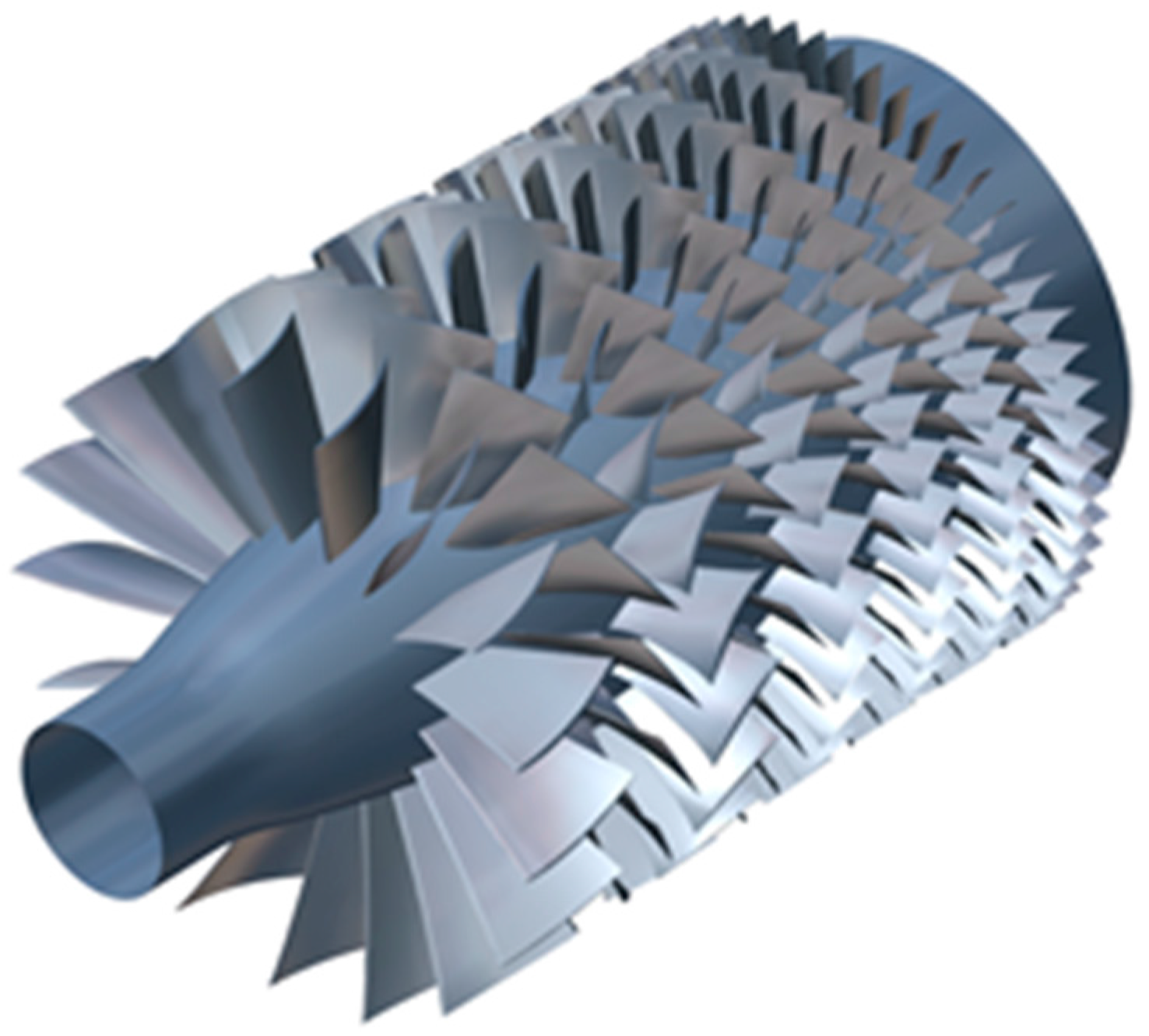


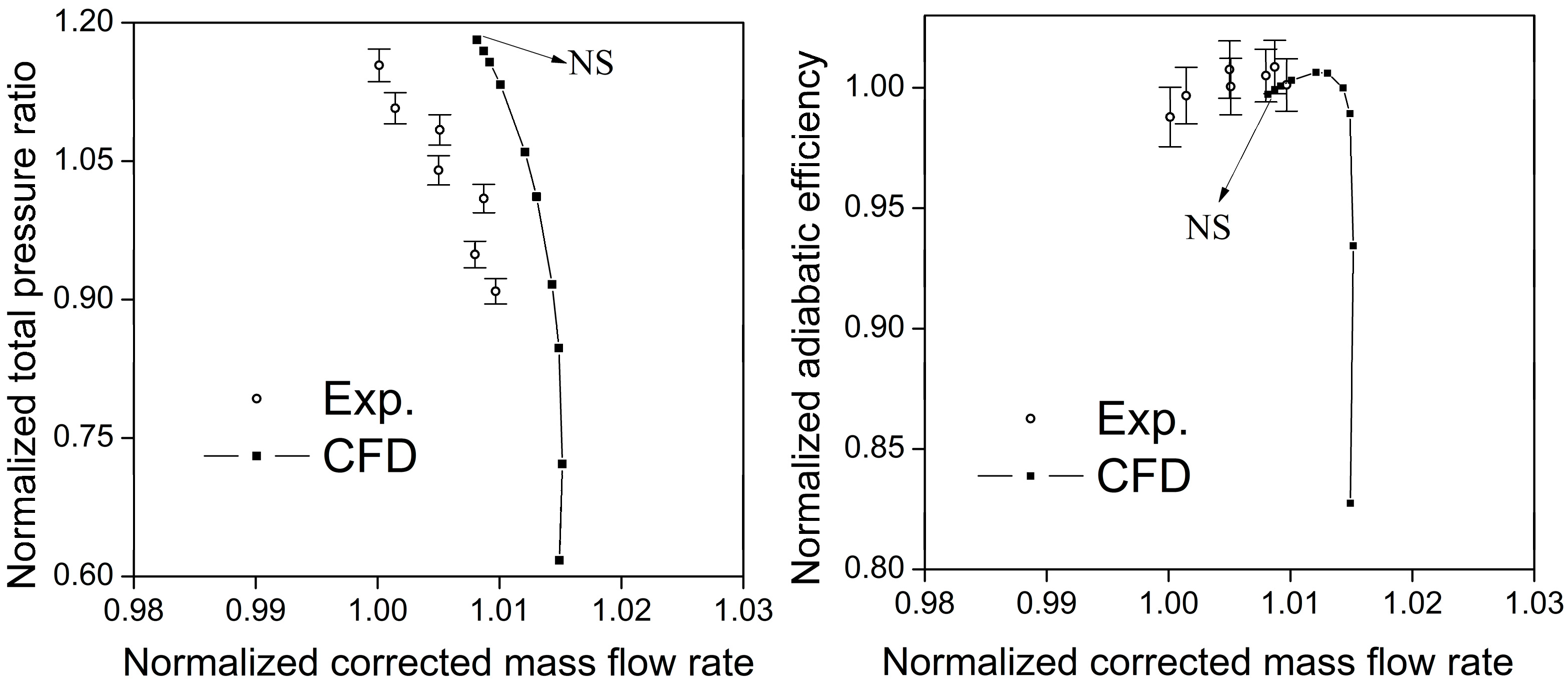
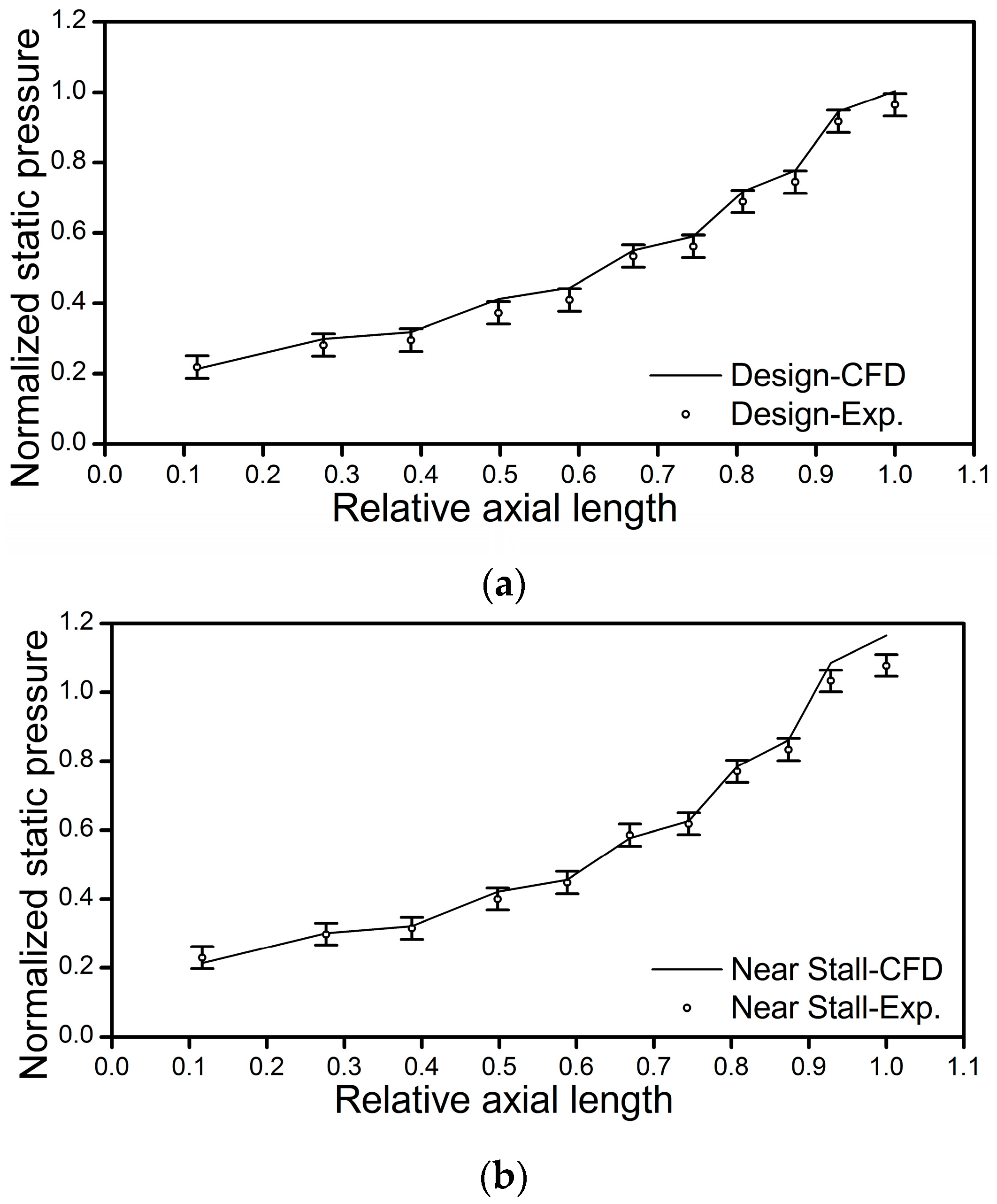

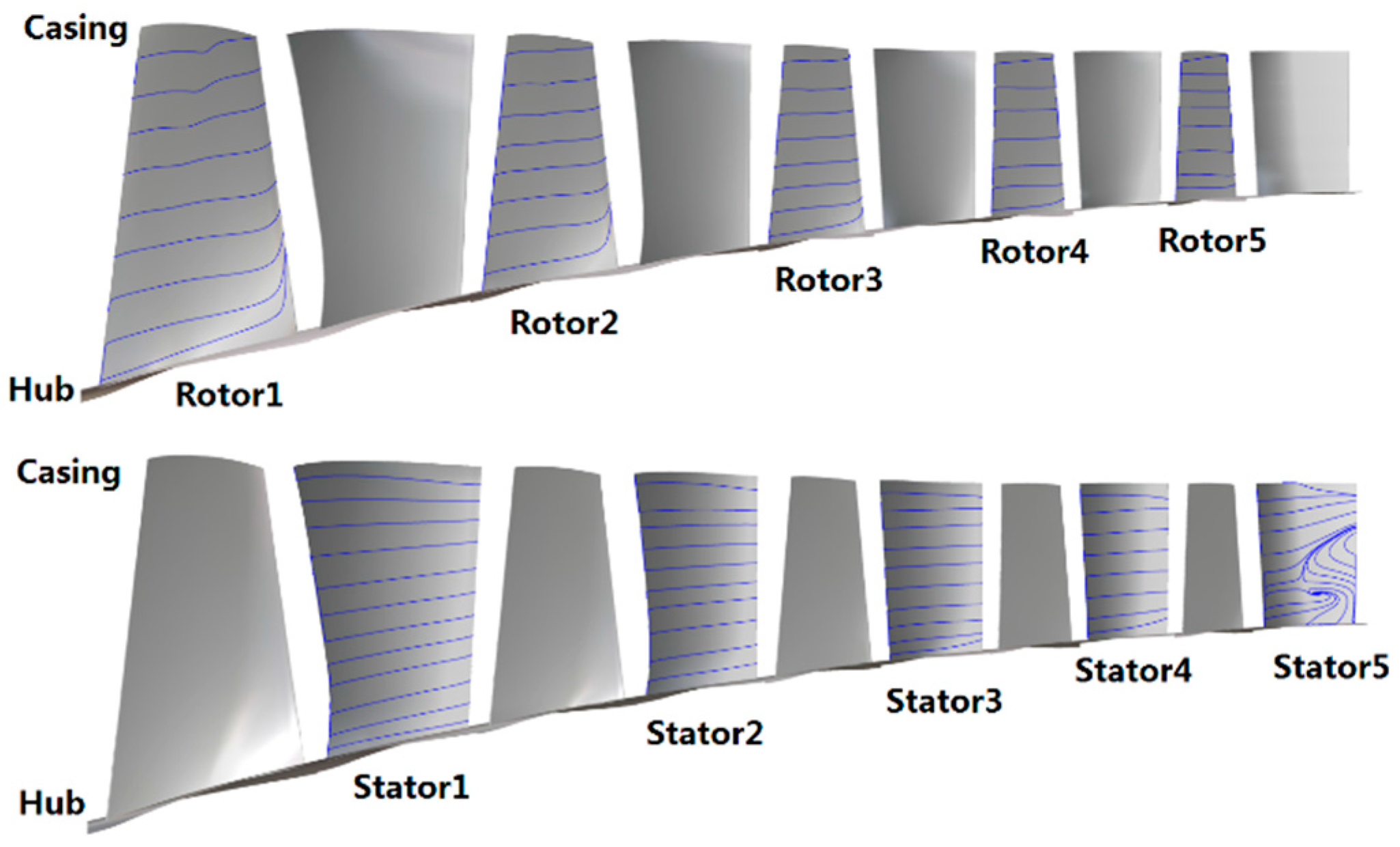
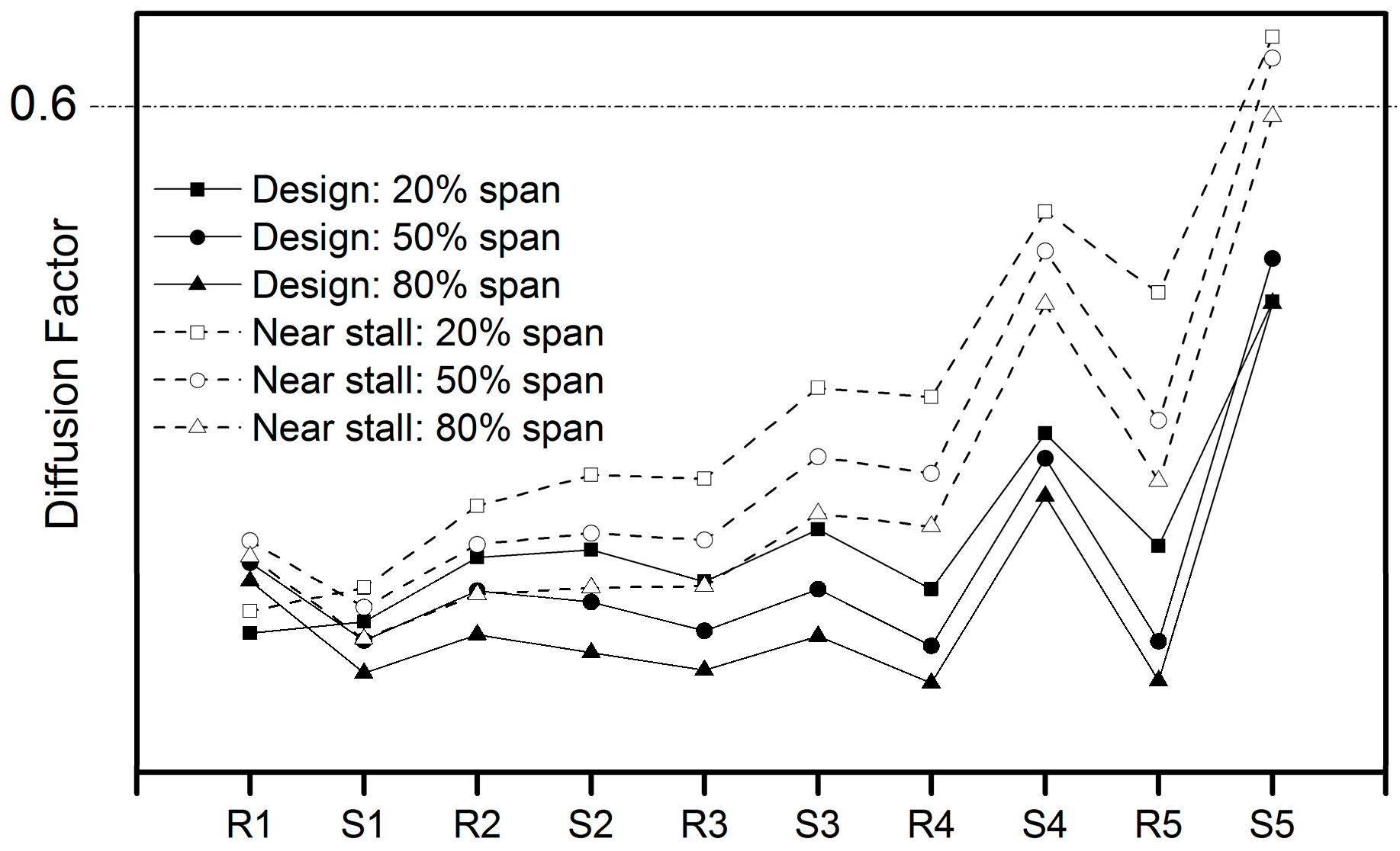
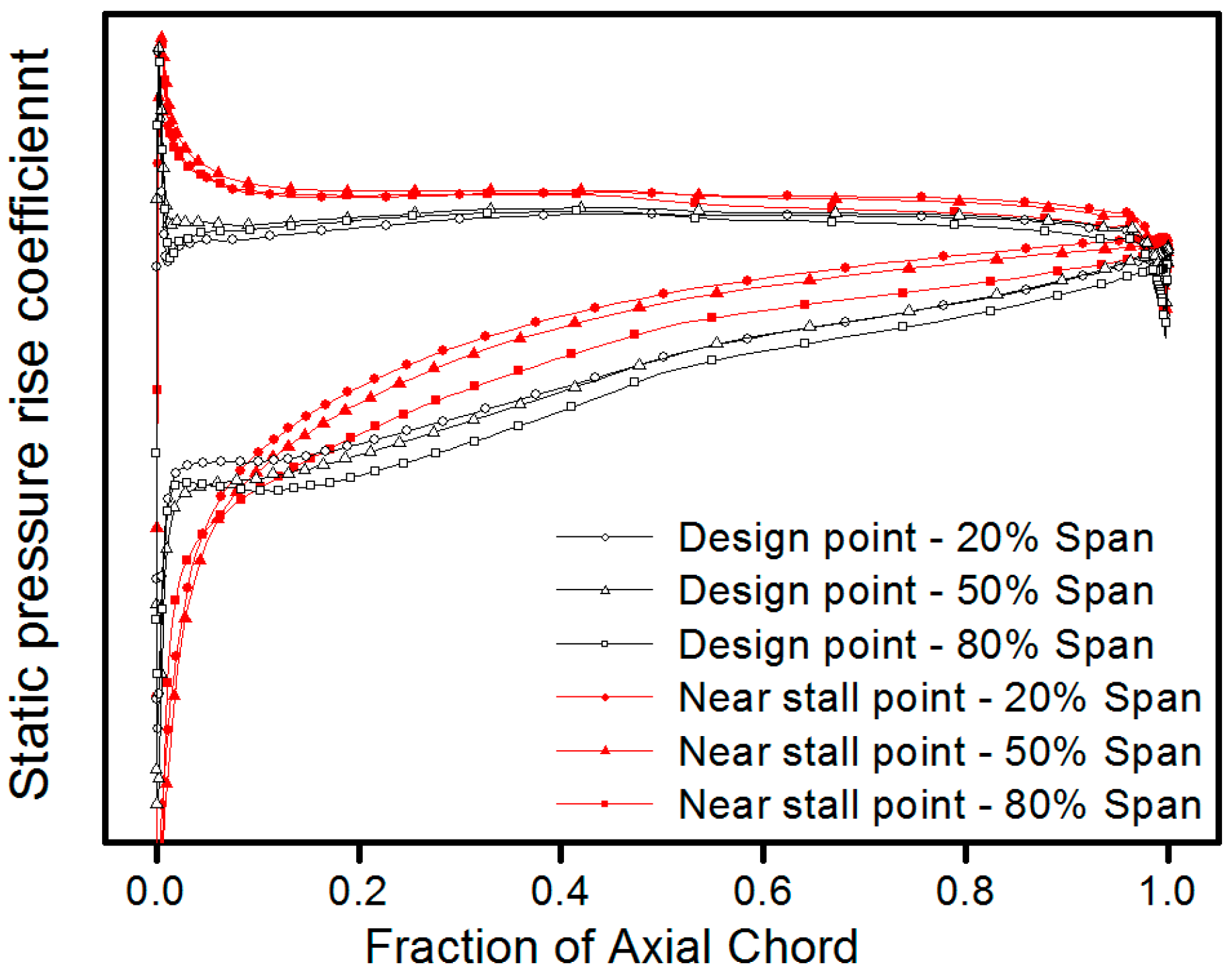
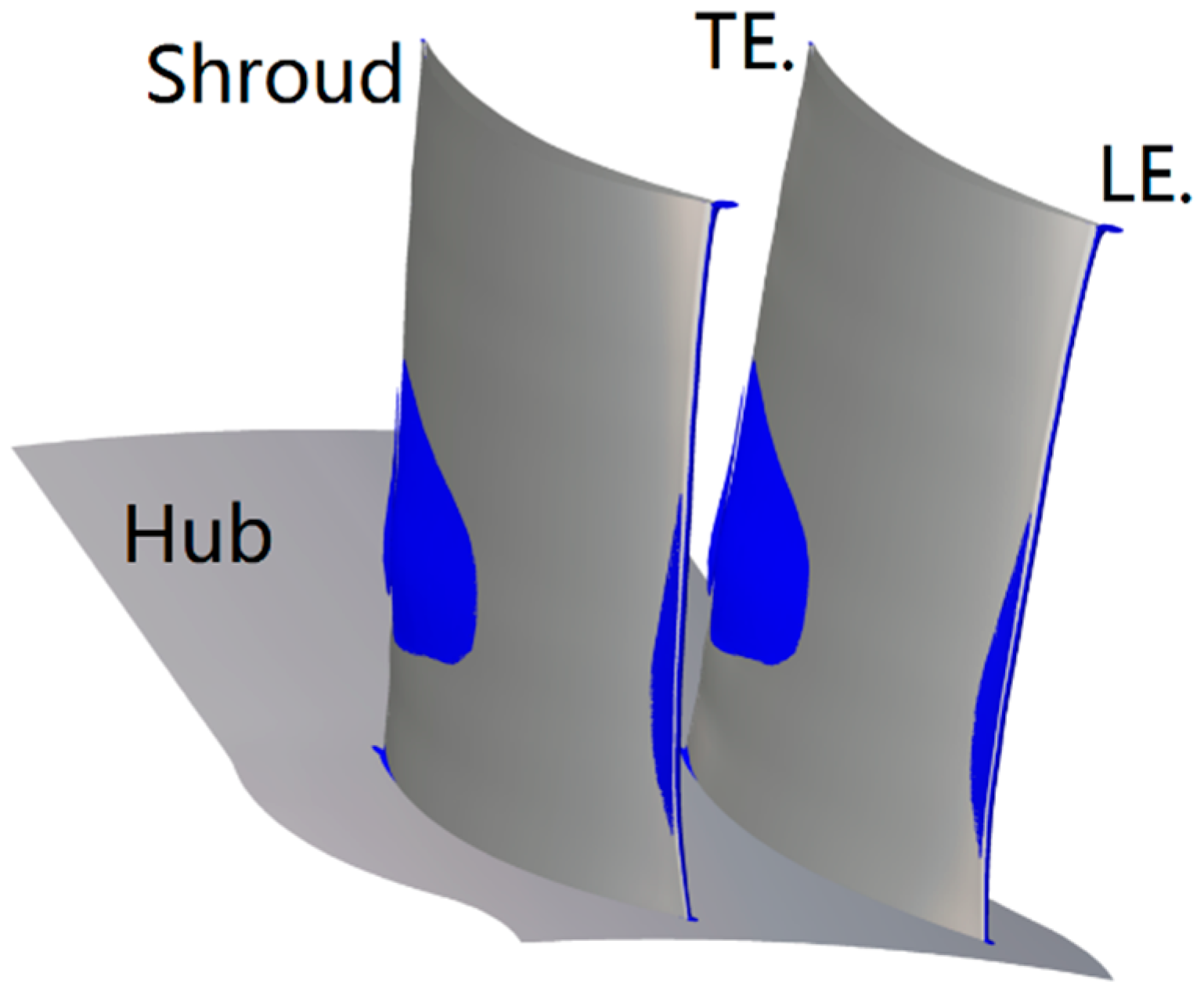
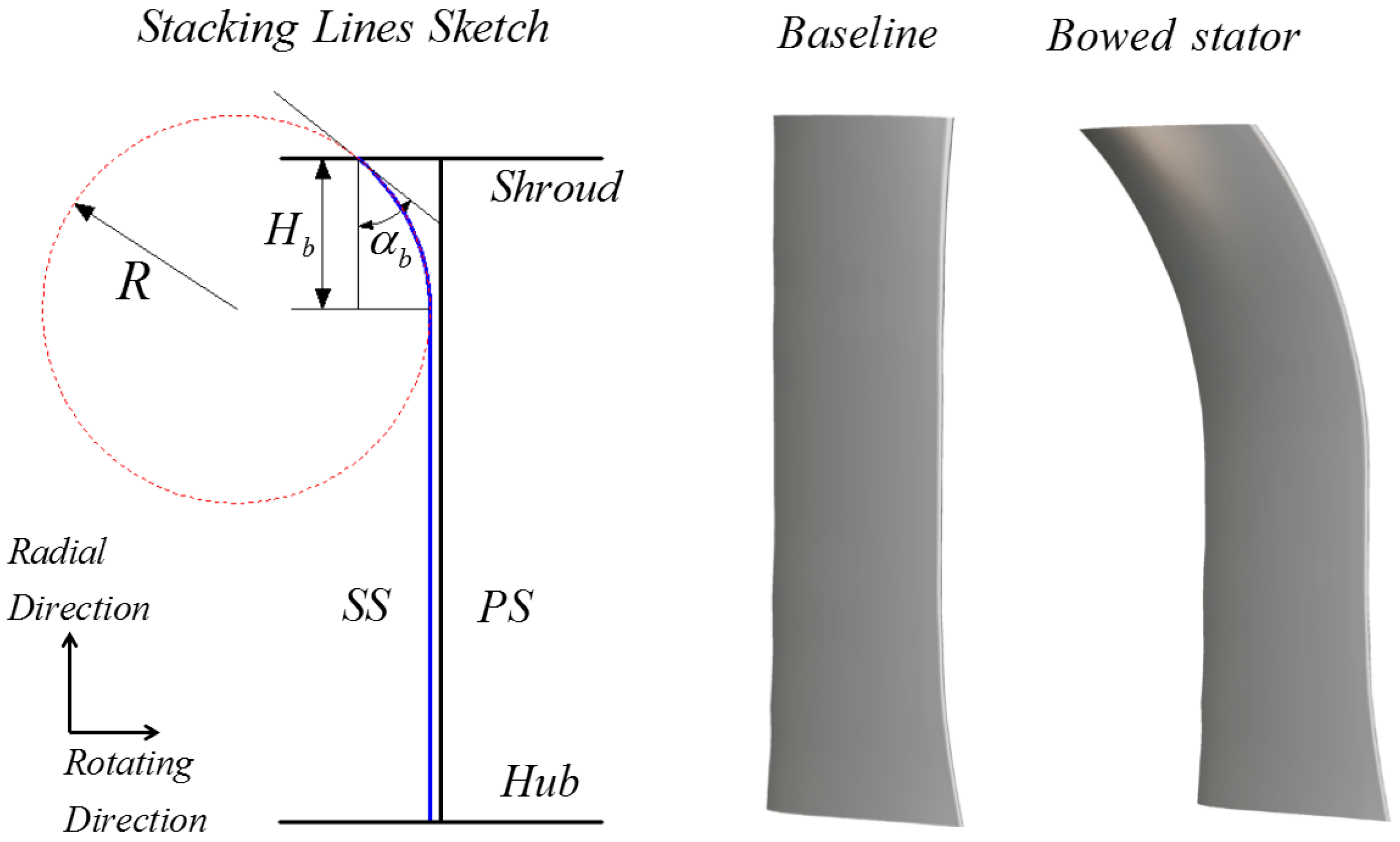
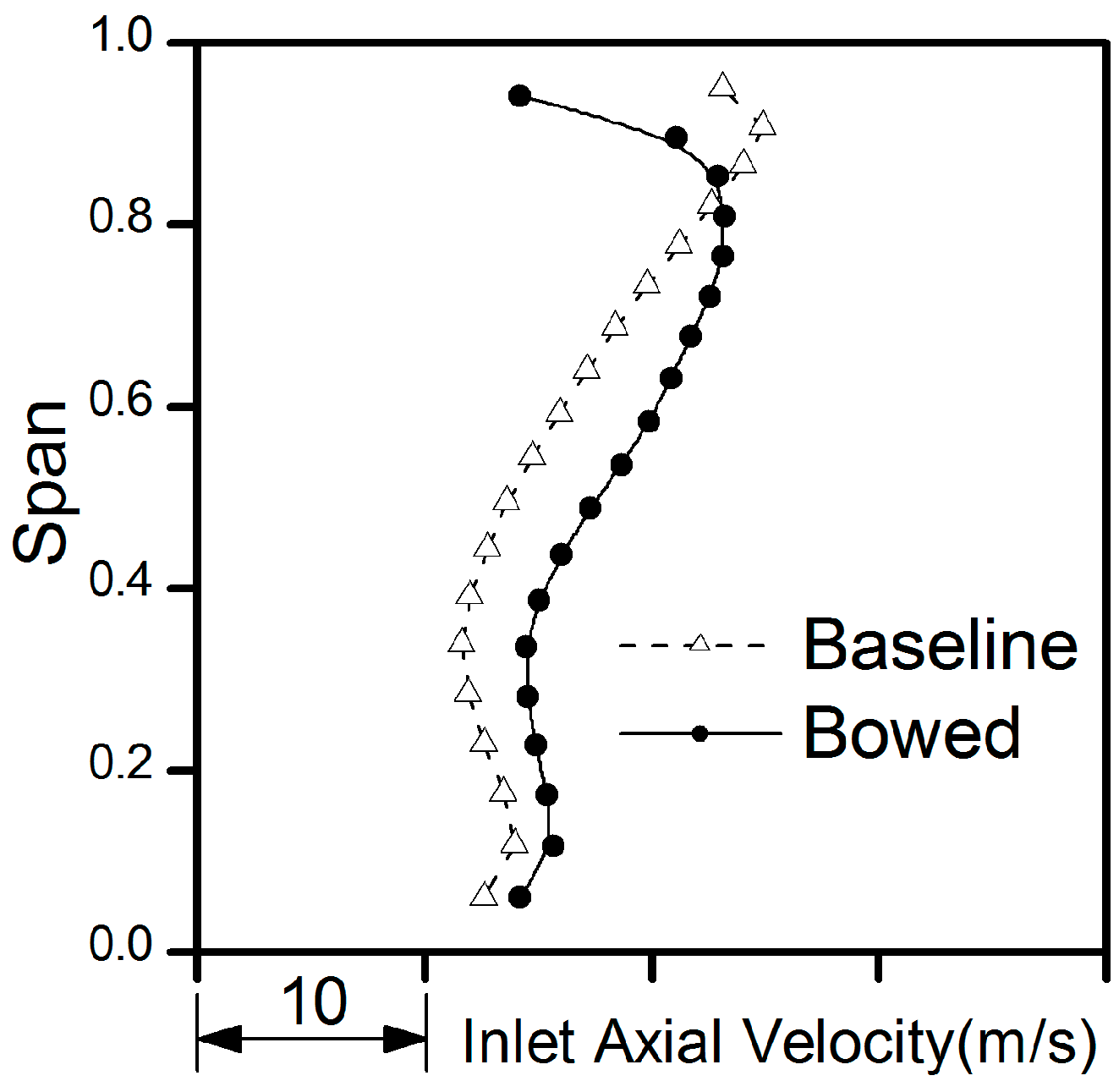
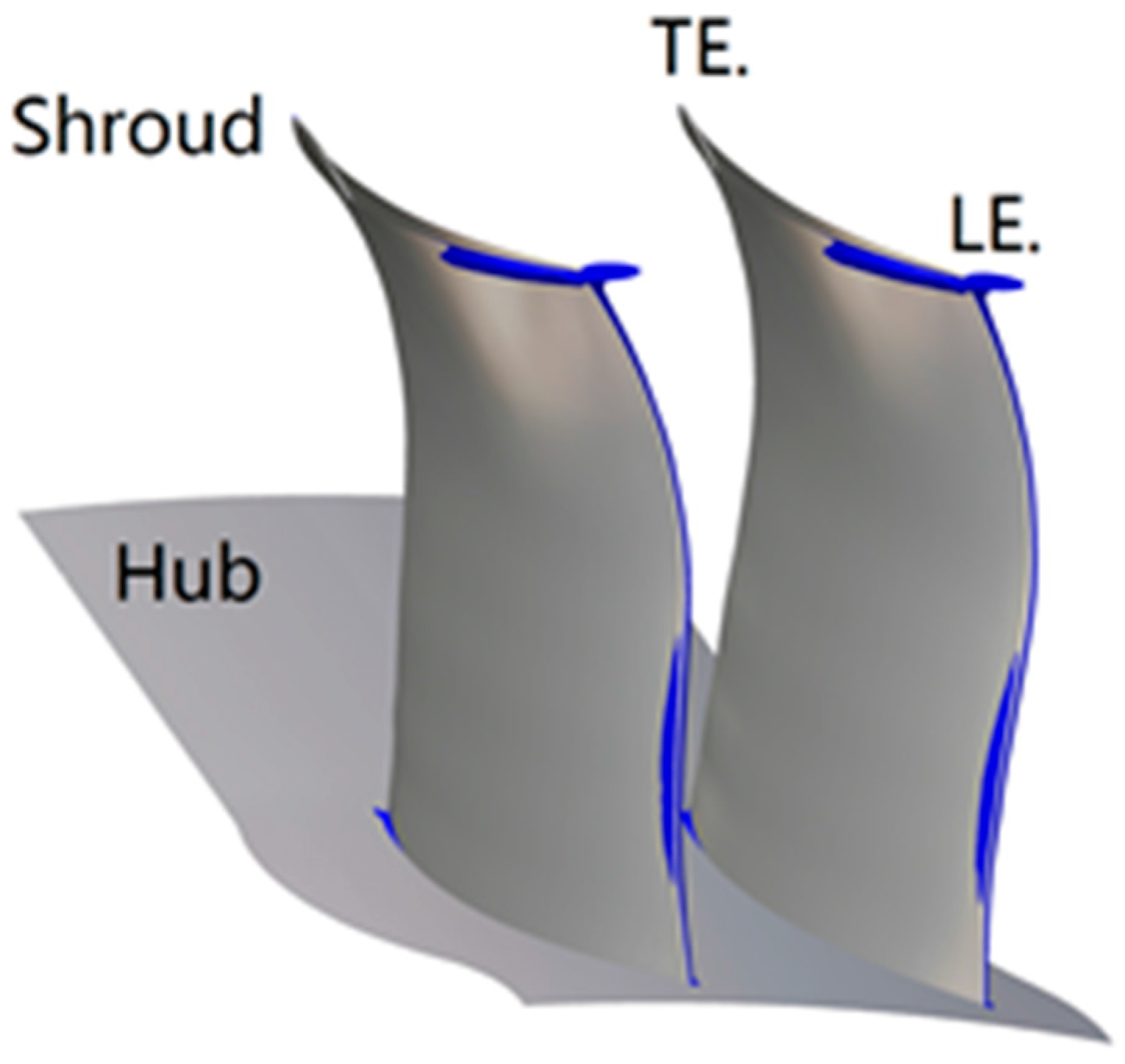
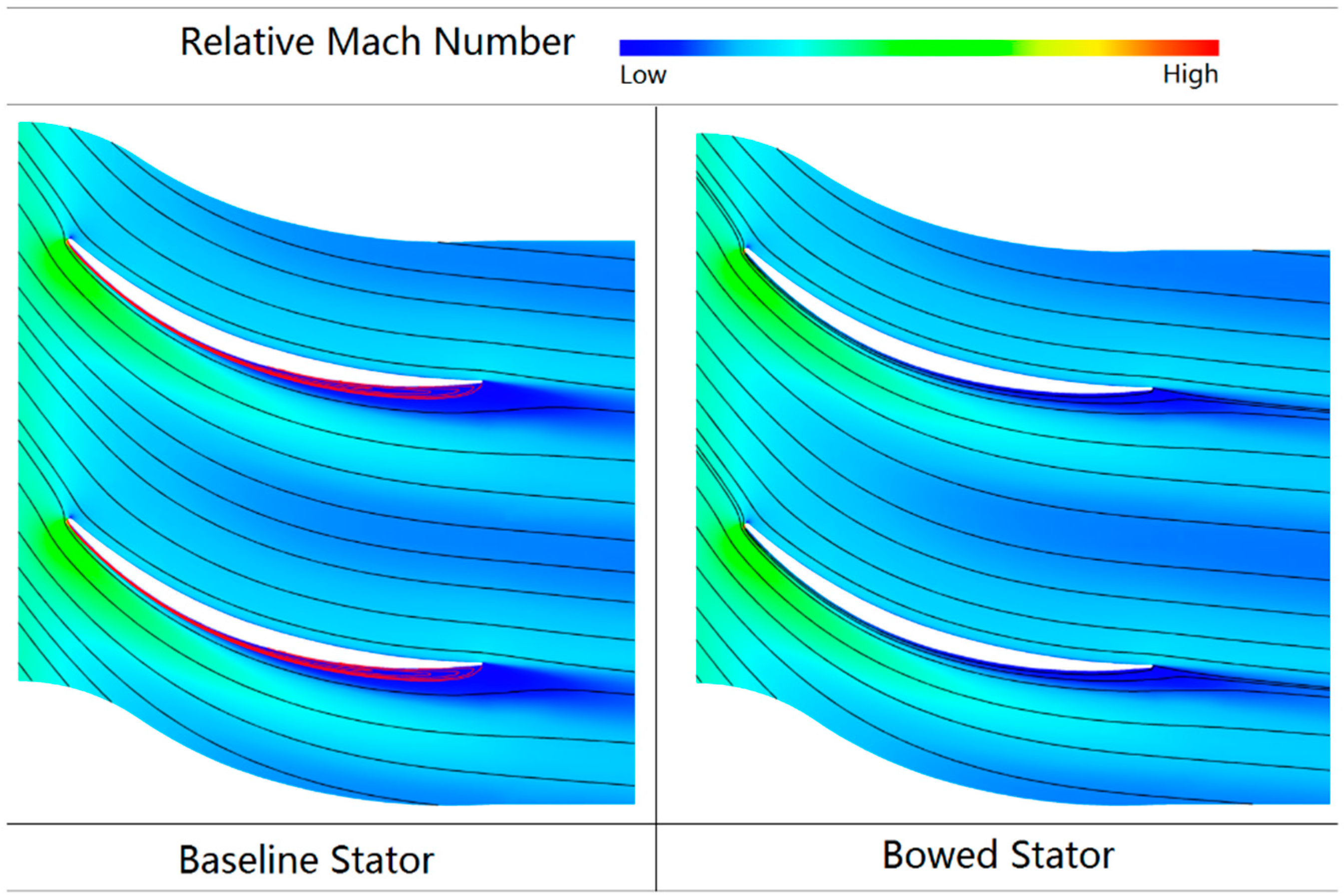
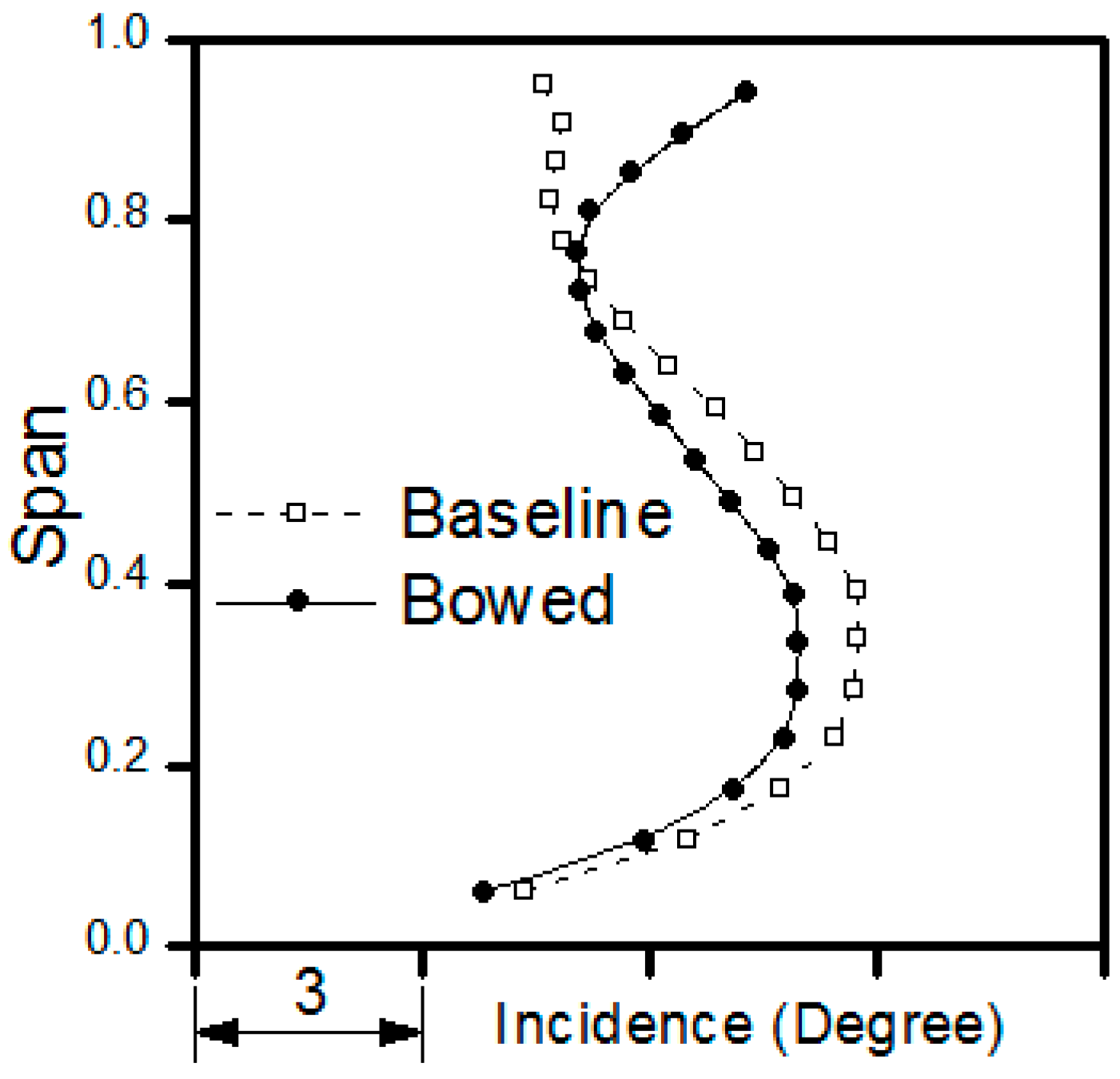
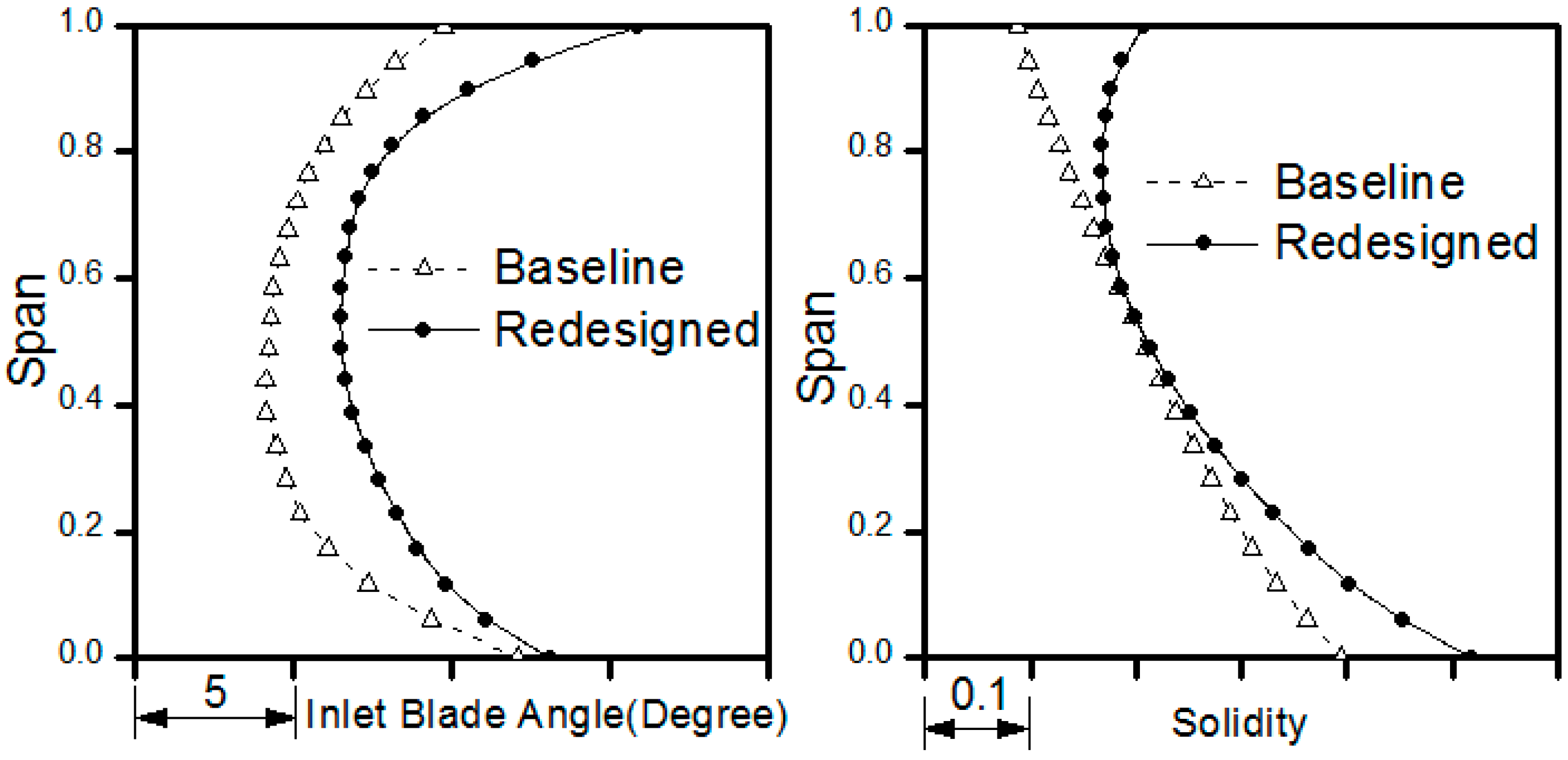
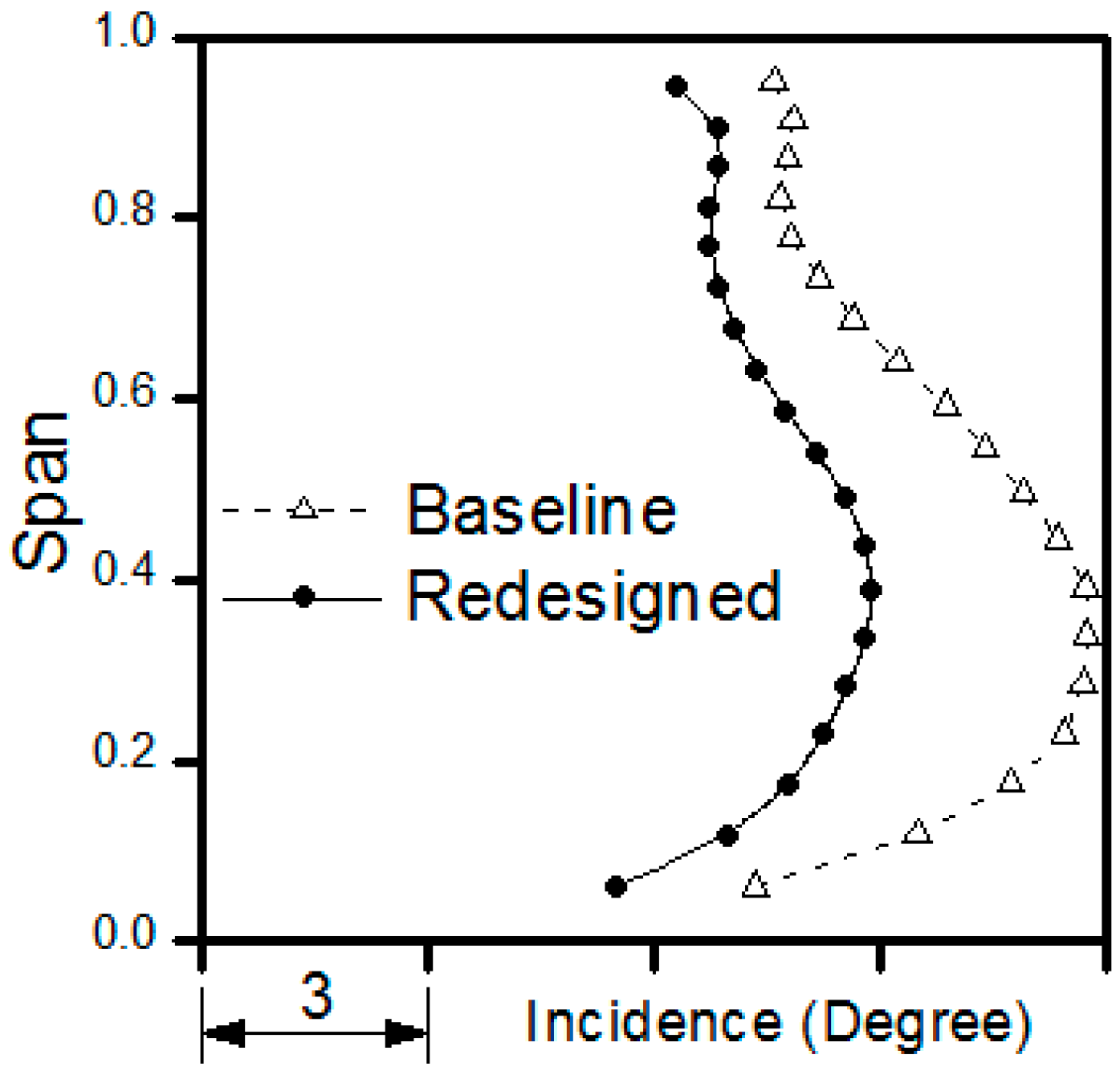
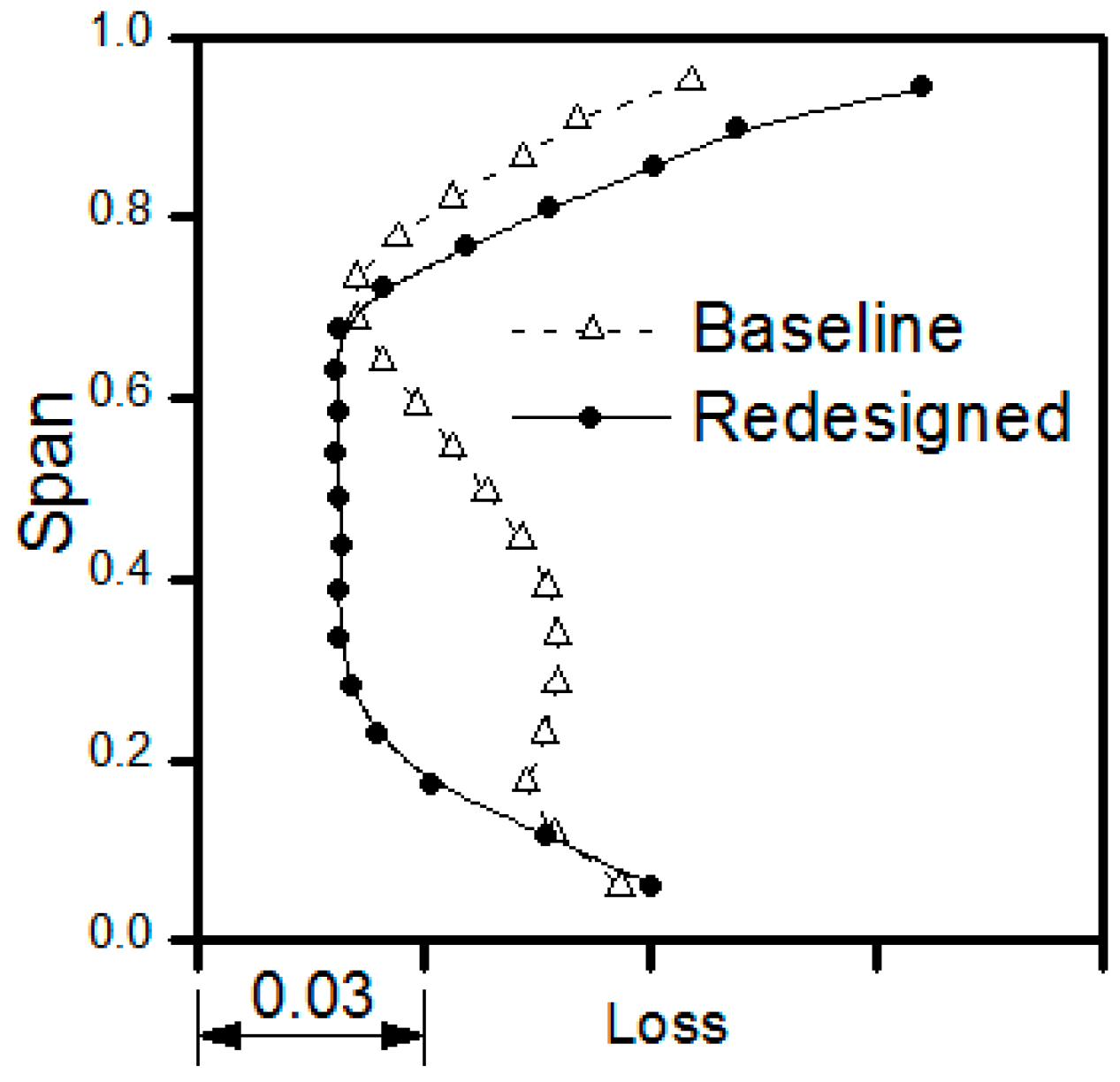
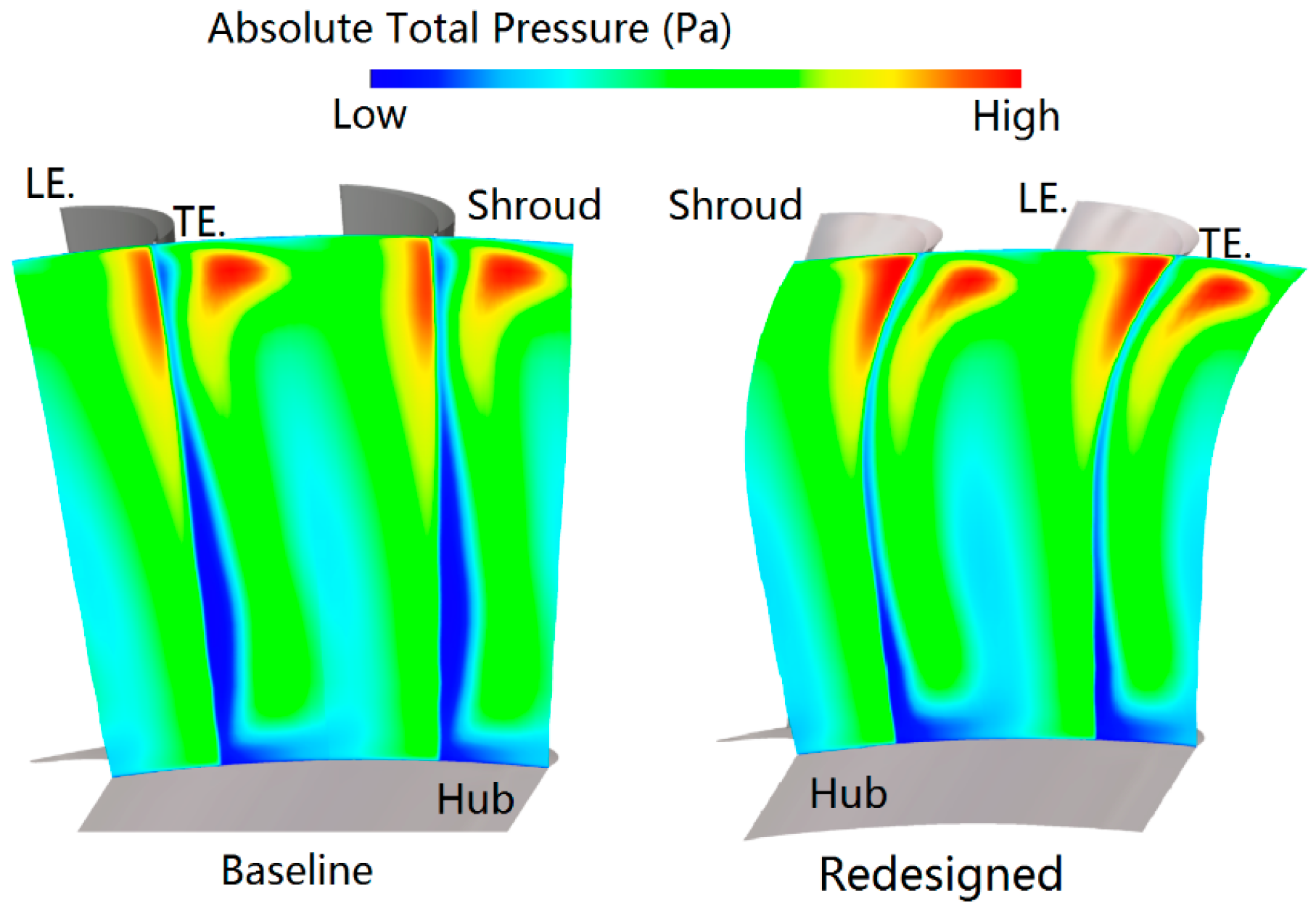
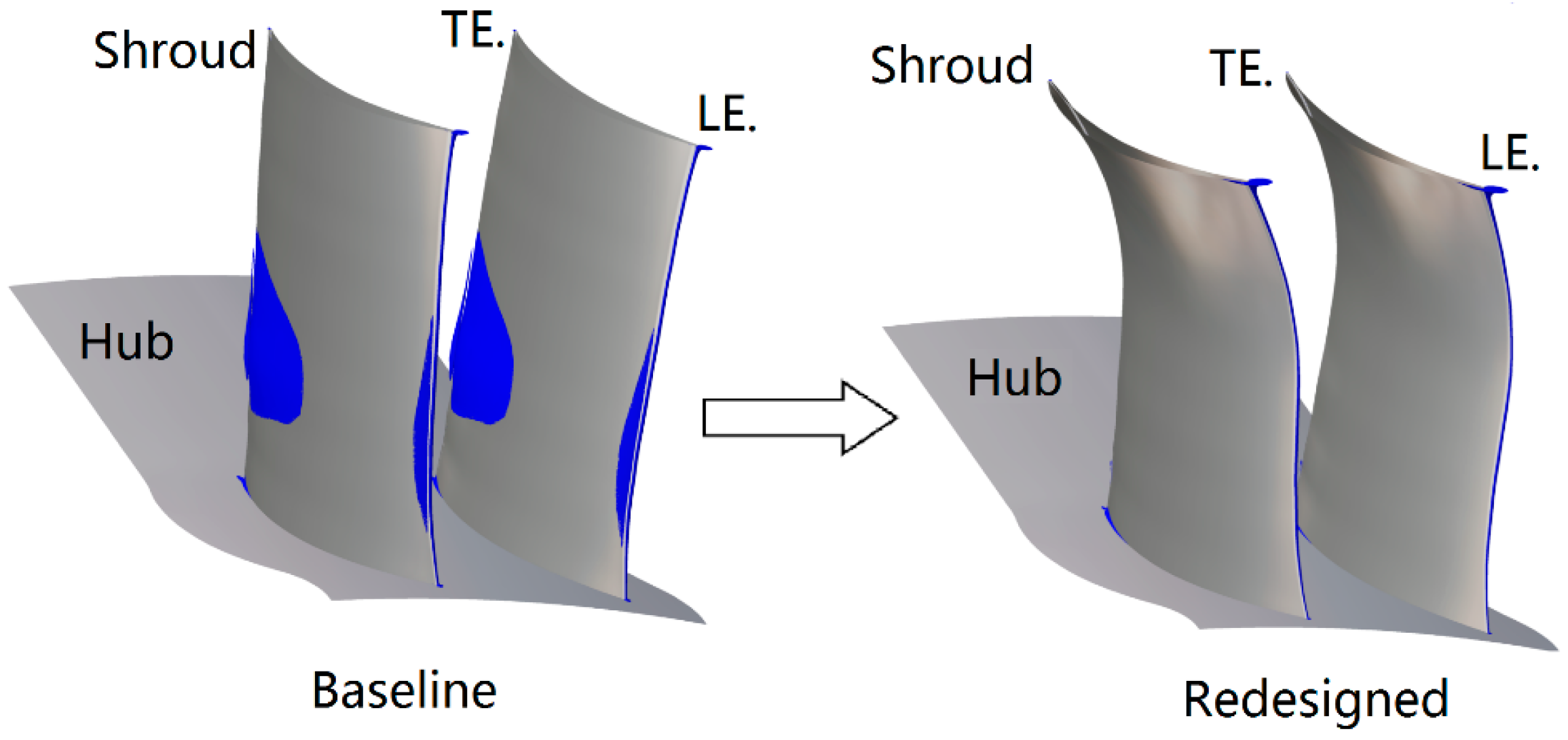
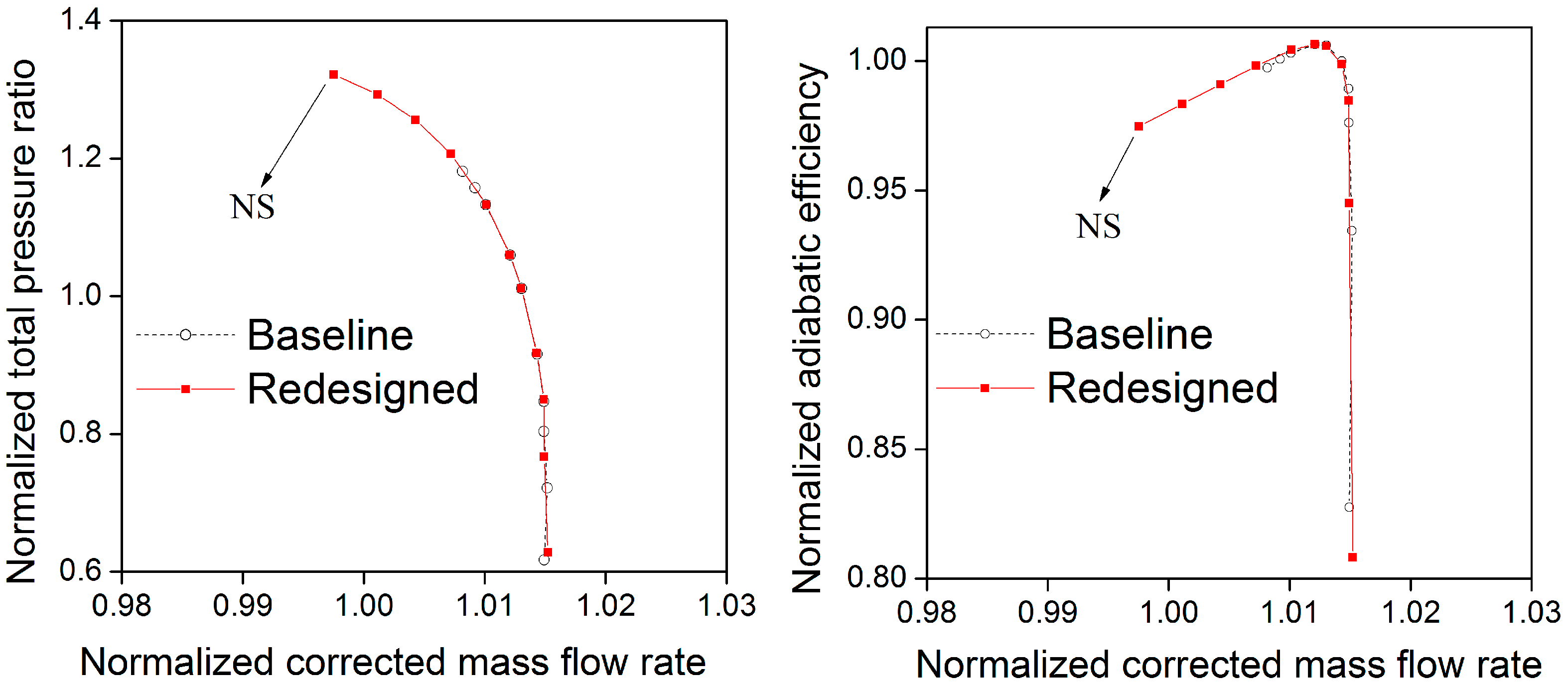
© 2016 by the authors; licensee MDPI, Basel, Switzerland. This article is an open access article distributed under the terms and conditions of the Creative Commons Attribution (CC-BY) license (http://creativecommons.org/licenses/by/4.0/).
Share and Cite
Ning, T.; Gu, C.-W.; Ni, W.-D.; Li, X.-T.; Liu, T.-Q. Aerodynamic Analysis and Three-Dimensional Redesign of a Multi-Stage Axial Flow Compressor. Energies 2016, 9, 296. https://doi.org/10.3390/en9040296
Ning T, Gu C-W, Ni W-D, Li X-T, Liu T-Q. Aerodynamic Analysis and Three-Dimensional Redesign of a Multi-Stage Axial Flow Compressor. Energies. 2016; 9(4):296. https://doi.org/10.3390/en9040296
Chicago/Turabian StyleNing, Tao, Chun-Wei Gu, Wei-Dou Ni, Xiao-Tang Li, and Tai-Qiu Liu. 2016. "Aerodynamic Analysis and Three-Dimensional Redesign of a Multi-Stage Axial Flow Compressor" Energies 9, no. 4: 296. https://doi.org/10.3390/en9040296




